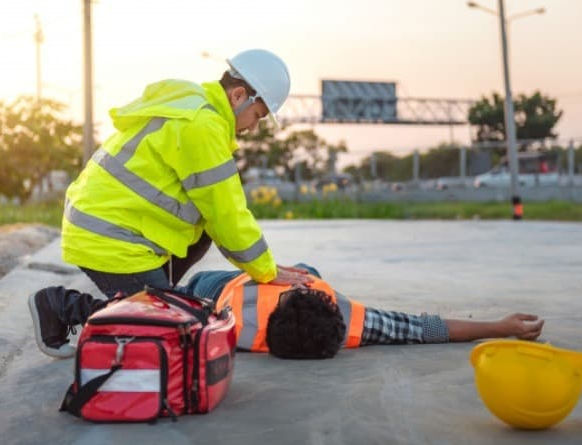Traumatic head injury first aid
Hard damage to the head can damage the brain and spinal cord, even if there are no obvious signs of head and face injuries. As a result, all types of head injuries should be treated seriously by a doctor and taken to the nearest hospital. Whenever possible, call an ambulance and do not delay.

Injuries to the head
There are two types of head injury:
Open
Having bleeding wounds on the face or head
Pack
Face and head appear to be uninjured
Injuries to the closed head
The skull protects the soft, jelly-like part of the brain. A transparent fluid surrounds the brain, which does not fully fill the skull. The liquid acts like a shock absorber, but its maintenance value is limited.
A small blow to the head or face can cause this fluid to absorb kinetic energy, resulting in an intracranial head fracture. Blood vessels may be torn or bruised in this condition.
When blood and blood serums do not work properly, intracranial swelling can occur and intracranial pressure can cause permanent brain damage.
Head injury signs and symptoms
The presence of bleeding does not indicate the severity of a head injury. Aside from the wounds, other symptoms of head injuries include:
Consciousness changes
A person may lose consciousness for a short or long time and regain consciousness or develop dizziness and drowsiness in such a situation. It may also have a short seizure and then recover for a short period and return to its previous state.
Skull deformation
Fractures are characterized by pressure on the skull or deformities.
Expelling transparent fluid from the ears and nose
Fractures of the skull, especially at the base, cause the ear and nose to leak transparent fluid.
Ear bruising and blackening of the eyes
Around the eyes and ears, these represent the force that enters the blood vessels.
Vision change
People may complain of blurred vision or double vision if their pupil grows large or has a different size.
Vomiting and nausea
A doctor should examine you if you experience any of these symptoms after a serious head injury.
Head injury first aid
-
It is always advisable to call an ambulance in the event of serious head injuries.
-
Tell the person to avoid shaking their head and neck if they are conscious.
-
To stop bleeding after head injuries, close the wounds. Obviously, you need to avoid direct and high pressure.
-
When examining the wound, be careful not to move blood vessels inside your hair.
-
Keep the person calm as much as possible.
-
If the person is unconscious, you should never shake him unless he is in grave danger.
-
Unnecessary shaking and movement can result in head injuries and damage to the spinal cord.
-
It’s just a matter of making sure the injury doesn’t worsen.
-
Until the ambulance arrives, ensure that the patient’s respiratory pathway is taken care of.
-
If you feel that the airflow is not sufficient, turn his head a little. By taking care of his head yourself, he will be able to breathe more easily.
-
Perform resuscitation operations if you are not breathing or have no pulse.
Concussion treatment
Trauma and injury can cause concussions. It is diagnosed by a doctor. If you do not seek medical attention, the situation may worsen. Up to three weeks can pass after a concussion.
Affected people and their families will receive the necessary instructions and care from the doctor and the hospital.
Any warning signs should be addressed by the family as soon as possible.
Symptoms such as persistent nausea, loss of body coordination, and worsening headaches.
Injuries to the spinal cord
Spinal cord injuries can also result from head injuries. A neck injury can also be caused by force in elderly people, whereas it is less common in young people. Keeping the head parallel to the neck is very important for this person.
-
Be careful not to shake or bend his head in any direction.
-
To keep a person’s head straight, wrap a T-shirt, towel, or dress around their neck.
-
Before the ambulance arrives, don’t shake this person too hard.
There are several signs and symptoms of spinal cord injury, including:
-
An abnormal position of the body when lying down
-
Skin cooling and moisturizing
-
Any irritation or unusual burning sensation in the head or neck
-
Different feet and organs cannot be moved
Children’s head injuries
Families should remember the following points when their children fall constantly:
-
The child falls on his or her own weight, which usually does not result in serious head injuries.
-
Nothing to do with the severity of the injury, just a little bump on the head.
-
Medications commonly prescribed to treat mild head injuries, such as swelling, can be administered by a doctor.
-
See your doctor as soon as possible if your child is nauseous and drowsy due to the injury.
-
Children can sustain head injuries when they fall down stairs, roll down a long path, fall on stiff ground, fall from bed to stiff ground, or turn their heads.
-
It is, however, better to avoid risks and see a doctor as soon as possible.
